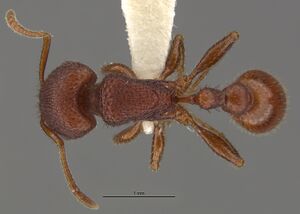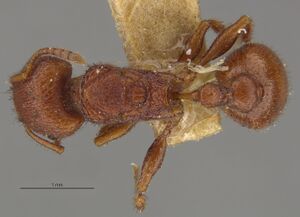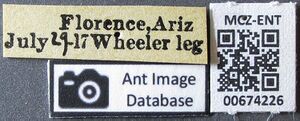Pogonomyrmex pima
| Pogonomyrmex pima | |
|---|---|

| |
| Scientific classification | |
| Kingdom: | Animalia |
| Phylum: | Arthropoda |
| Class: | Insecta |
| Order: | Hymenoptera |
| Family: | Formicidae |
| Subfamily: | Myrmicinae |
| Tribe: | Pogonomyrmecini |
| Genus: | Pogonomyrmex |
| Species group: | pima |
| Species: | P. pima |
| Binomial name | |
| Pogonomyrmex pima Wheeler, W.M., 1909 | |
| At a Glance | • Ergatoid queen |
My eleven nests of this species were nearly equally divided as to their location beneath stones (five) and without a covering object (six). Each of two of the latter nests bore a small, low crater about 3 inches in diameter. The workers forage singly at a slow and steady gait and, like those of imberbiculus, are extremely docile ants. Food consists largely of seeds, but some dead arthropods are incorporated into the diet. (Cole 1968)
Identification
Keys including this Species
- Key to North American Pogonomyrmex
- Key to Pogonomyrmex of Hispaniola
- Key to South American Pogonomyrmex
Distribution
United States: southern Arizona. Mexico: Sonora.
Latitudinal Distribution Pattern
Latitudinal Range: 36.333333° to 20.39825°.
| North Temperate |
North Subtropical |
Tropical | South Subtropical |
South Temperate |
- Source: AntMaps
Distribution based on Regional Taxon Lists
Nearctic Region: United States (type locality).
Neotropical Region: Mexico.
Distribution based on AntMaps
Distribution based on AntWeb specimens
Check data from AntWeb
Countries Occupied
| Number of countries occupied by this species based on AntWiki Regional Taxon Lists. In general, fewer countries occupied indicates a narrower range, while more countries indicates a more widespread species. |

|
Estimated Abundance
| Relative abundance based on number of AntMaps records per species (this species within the purple bar). Fewer records (to the left) indicates a less abundant/encountered species while more records (to the right) indicates more abundant/encountered species. |

|
Nests of P. pima have been found from sea level to elevations of 2,400 feet.
Biology
Castes
Dimorphic queens are produced: winged and ergatoid (Johnson et al. 2007)
Worker
   
| |
| Worker. . | Owned by Museum of Comparative Zoology. |
Queen
   
| |
| Queen (ergatoid). . | Owned by Museum of Comparative Zoology. |
Images from AntWeb
   
| |
| Queen (ergatoid). Specimen code casent0006300. Photographer April Nobile, uploaded by California Academy of Sciences. | Owned by CAS, San Francisco, CA, USA. |
  
| |
| Queen (alate/dealate). Specimen code casent0006304. Photographer April Nobile, uploaded by California Academy of Sciences. | Owned by CAS, San Francisco, CA, USA. |
Male
   
| |
| Male. . | Owned by Museum of Comparative Zoology. |
Nomenclature
The following information is derived from Barry Bolton's Online Catalogue of the Ants of the World.
- pima. Pogonomyrmex (Ephebomyrmex) pima Wheeler, W.M. 1909e: 79 (w.) U.S.A. Cole, 1968: 175 (q.m.); Johnson, R.A. et al. 2007: 79 (ergatoid q.).
Unless otherwise noted the text for the remainder of this section is reported from the publication that includes the original description.
Description
Worker
Cole (1968) - HL 1.11-1.19 mm, HW 1.09-1.17 mm, CI 91.6-100.9, SL 0.80-0.82 mm, SI 70.1-73.4, EL 0.24-0.29 mm, EW 0.17-0.20 mm, OI 20.2-26.1, WL 1.48-1.53 mm, PNL 0.27-0.31 mm, PNW 0.34-0.41 mm, PPL 0.31-0.37 mm, PPW 0.53-0.58 mm.
Mandible (Pl. III, Fig. 20) similar to that of imberbiculus, but second basal tooth notably shorter than third, nearly as small as penultimate which is much smaller than third basal; ultimate basal tooth absent; basal mandibular border faintly and broadly convex. Antennal scape (Pl. I, Fig. 6) similar lo lhal of imberbiculus.
Eye placed distinctly anterior to middle of side of head. Anterior border of clypeus entire, without a projection in front of each antennal fossa. Contours of thorax, petiole, and postpetiole as shown in Pl. V, Fig. 9; dorsum of petiolar and postpctiolar nodes as in Pl. VII, Fig. 26. Petiolar node, in lateral view, conical, its apex acute; anterior declivity rather long and straight, subequal to length of poslerior declivity, meeting the peduncle at a pronounced, well-rounded angle. Head, thorax, petiole, and postpetiole opaque. Head coarsely, longitudinally rugose to rugo-reticulose. Thorax coarsely rugo-reticulose. Interrugal spaces finely and densely punctate. Peliolar node and postpetiole shagreened and faintly punctate, the pctiolar node frequently with a few, irregular, longitudinal rugulae. Pilosity as in imberbiculus. Color a deep, ferrugineous red; the appendages paler.
Queen
Cole (1968) - HL 1.11-1.19 mm, HW 1.09-1.17 mm, CI 91.6-100.9. SL 0.80-0.82 mm, SI 70.1-73.4, EL 0.24-0.29 mm, EW 0.17-0.20 mm, OI 20.2-26.1, WL 1.48-1.53 mm, PNL 0.27-0.31 mm, PNW 0.34-0.41 mm, PPL 0.34-0.37 mm, PPW 0.53-0.58 mm.
Head, petiole, and postpetiole similar to those of the worker. Contours of thorax, petiole, and postpetiole as shown in Pl. IX, Fig. 6.
Head longitudinally rugose on front and genae, rugo-reticulose on vertex and occiput, the interrugal spaces densely and finely punctate, the surface dull; frontal area shining, bearing two longitudinal rugae; clypeus longitudinally rugose, the interrugal spaces without sculpture. Pronotal collar faintly, transversely striate; sides of thorax rugo-reticulose, the rugae with a longitudinal trend, the interspaces without perceptible sculpture; scutal dorsum longitudinally rugose, the interspaces densely and finely punctured; sides of scutum irregularly and rather weakly rugo-reticulose. Scutellum longitudinally rugose, the interspaces with sparse, fine, scattered punctures. Base of epinotum with a few, coarse, wavy, transverse rugae, the interspaces smooth and shining. Petiolar node shagreened; postpetiolar node densely and very finely punctate and faintly and sparsely striate; ventral lobe of postpetiole densely and finely punctate. Base of gastric dorsum with prominent piligerous punctures.
Hairs short, uneven. both straight and curved, the pattern similar to that of the worker; those on wing membrane as in the female of imberbiculus.
Head, thorax, petiole, post petiole, and appendages subopaque; gaster finely shagreened and moderately shining. Color a deep, rich, ferrugineous red; sides of scutum and terminal half of gaster infuscated.
Described, for the first time, from a nest queen collected by the writer 2 mi. N. of Magdelina, Sonora, Mexico, August 7, 1959, and 9 alate females, also collected by me, from a nest 65 mi. N. of Hermosillo, Sonora, Mexico, August 14, 1 961.
Male
Cole (1968) - HL 0.87 mm, HW 0.92 mm, CI 102.4, SL 0.22 mm, SI 23.9, EL 0.36 mm, EW 0.27 mm, OI 41.4, WL 1.43 mm, PNL 0.27 mm, PNW 0.27 mm, PPL 0.34 mm, PPW 0.44 mm.
Head shape similar to that of the imberbiculus male; transverse occipital keel pronounced; in frontal view, sides of head beneath the eyes strongly constricted, very short, subparallel. Eyes very large, elongate, strongly protruding from sides of head. Mandible as shown in Pl. VIII, Fig. 19; blade much broader distally than proximally, without a bend, apical and basal margins not subparallel; masticatory margin with 6 teeth, basalmost tooth the smallest and meeting basal mandibular margin evenly at a straight angle. Antennal scape very short; pedicel short, subglobular; flagellum notably shorter than that of imberbiculus, being less than three times the head width, with segments 6, 7, 8, and 9 markedly narrower than any of the preceding segments.
Contours of thorax, petiole, and postpetiole as shown in Pl. IX, Fig. 7; dorsum of petiolar and postpetiolar nodes as in Pl. XII, Fig. 18. Apex of petiolar node, in lateral view, flattened, strongly and very broadly truncate; anterior declivity of node notably steeper than posterior declivity, the length of the two subequal.
Head finely and densely punctate; prominently, moderately coarsely, irregularly, longitudinally rugose on front and on midvertex to the occipital border; rugae on vertex above eyes coarse, wavy, reticulate, with a longitudinal trend; several somewhat less coarse rugae radiate outward both laterally and posteriorly from each lateral ocellus and from median ocellus to each lateral ocellus; frontal area smooth and shining; antennal scape finely, irregularly, longitudinally striate. Sides of thorax, except mesothoracic epimera, with numerous, coarse, irregular, wavy rugae with a longitudinal trend; mesothoracic epimera largely finely punctate, with a few, irregular, longitudinal rugulae; scutum strongly shining, with only sparse, large, piligerous punctures; paraptera coarsely, transversely rugose, the rugae widely spaced, the interrugal spaces shining, epinotum very coarsely, irregularly, longitudinally rugose; Maynan and parapsidal furrows prominent. Head and thorax, except frontal area and scutum, largely opaque; antennae, legs, and gaster shining; petiole and postpetiole smooth, faintly shagreened, strongly shining.
Body densely hairy. Hairs long, slender, both straight and curved, as long on venter of head as on dorsum; on antennal scape moderately long, erect and suberect; on eyes rather numerous, short, straight, erect; on epinotum notably shorter and sparser than elsewhere on thorax; absent from venter of petiole and its peduncle. Entire surface of gaster with abundant, delicate, pointed, golden hairs very irregular in length. Pilosity of wing membrane as in the imberbiculus male. Body a deep brownish black; appendages a little lighter.
Described, for the first time, from a unique collected by the writer at Douglas, Arizona, July 3, 1956. Inasmuch as the foregoing description applies to the only specimen available, there has been no opportunity to evaluate the degree of intraspecific variation of characters in the male caste.
Type Material
Type locality: Tucson and Phoenix, Arizona.
References
- Alatorre-Bracamontes, C.E., Vásquez-Bolaños, M. 2010. Lista comentada de las hormigas (Hymenoptera: Formicidae) del norte de México. Dugesiana 17(1): 9-36.
- Cole, A. C., Jr. 1968. Pogonomyrmex harvester ants. A study of the genus in North America. Knoxville, Tenn.: University of Tennessee Press, x + 222 pp. (page 175, queen, male described)
- Jansen, G., Savolainen, R. 2010. Molecular phylogeny of the ant tribe Myrmicini (Hymenoptera: Formicidae). Zoological Journal of the Linnean Society 160(3), 482–495 (doi:10.1111/j.1096-3642.2009.00604.x).
- Johnson, R.A. 2010. Independent colony founding by ergatoid queens in the ant genus Pogonomyrmex: queen foraging provides an alternative to dependent colony founding. Insectes Sociaux 57, 169–176 (doi:10.1007/s00040-010-0065-6).
- Johnson, R.A., Borowiec, M.L., Snelling, R.R., Cole, A.C. 2022. A taxonomic revision and a review of the biology of the North American seed-harvester ant genus Veromessor (Hymenoptera: Formicidae: Myrmicinae). Zootaxa 52061, 1-115 (doi:10.11646/zootaxa.5206.1.1).
- Johnson, R.A., Holbrook, C.T., Strehl, C., Gadeau, J. 2007. Population and colony structure and morphometrics in the queen dimorphic harvester ant, Pogonomyrmex pima. Insectes Sociaux 54, 77-86 (doi:10.1007/s00040-007-0916-y).
- JOHNSON, R.A., HOLBROOK, C.T., STREHL, C. & GADAU, J. 2007. Population and colony structure and morphometrics in the queen dimorphic harvester ant, Pogonomyrmex pima. Insectes Sociaux 54: 77-86.
- Wheeler, W. M. 1909e. A decade of North American Formicidae. J. N. Y. Entomol. Soc. 17: 77-90 (page 79, worker described)
References based on Global Ant Biodiversity Informatics
- Alatorre-Bracamontes, C.E. and M Vasquez-Bolanos. 2010. Lista comentada de las hormigas (Hymenoptera: Formicidae) del norte de México. Dugesiana 17(1):9-36
- Cole A. C., Jr. 1937. An annotated list of the ants of Arizona (Hym.: Formicidae). [concl.]. Entomological News 48: 134-140.
- Cole A. C., Jr. 1966. Keys to the subgenera, complexes, and species of the genus Pogonomyrmex (Hymenoptera: Formicidae) in North America, for identification of the workers. Annals of the Entomological Society of America 59: 528-530.
- Cole, A.C. 1968. Pogonomyrmex harvester ants: A study of the genus in North America. University of Tennesee Press. Knoxville
- Creighton W. S. 1957. Studies on the North American representatives of Ephebomyrmex (Hymenoptera: Formicidae). Psyche (Cambridge) 63: 54-66.
- Dattilo W. et al. 2019. MEXICO ANTS: incidence and abundance along the Nearctic-Neotropical interface. Ecology https://doi.org/10.1002/ecy.2944
- Fernandes, P.R. XXXX. Los hormigas del suelo en Mexico: Diversidad, distribucion e importancia (Hymenoptera: Formicidae).
- Holbrook, C.T., C.-P. Strehl, R.A. Johnson and J. Gadau. 2007. Low Queen Mating Frequency in the Seed-Harvester Ant Pogonomyrmex (Ephebomyrmex) pima: Implications for the Evolution of Polyandry. Behavioral Ecology and Sociobiology 62(2)229-236
- Johnson R. Personnal Database. Accessed on February 5th 2014 at http://www.asu.edu/clas/sirgtools/resources.htm
- Mackay, W.P., E.E. Mackay, J.F. Perez Dominguez, L.I. Valdez Sanchez and P.V. Orozco. 1985. Las hormigas del estado de Chihuahua Mexico: El genero Pogonomyrmex (Hymenoptera: Formicidae) . Sociobiology 11(1):39-54
- Vásquez-Bolaños M. 2011. Lista de especies de hormigas (Hymenoptera: Formicidae) para México. Dugesiana 18: 95-133

